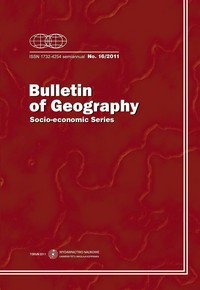Population of American Cities: 1950-2009
DOI:
https://doi.org/10.1515/v10089-011-0020-yKeywords
USA, cities, population changeAbstract
Contrary to the industrial epoch, cities have been interpreted in the last fifty years as the places facing the greatest economic and social problems. A contrasting view has emerged only recently that takes cities as sites of economic dynamism and social vitality. The paper offers evidence on population change for 118 greatest cities of the United States of America to assess how their fortunes have changed from the 1950s to 2009. Considerable diversity of experience was revealed and seven categories of cities have been distinguished as far as their population change patterns are concerned. These categories range from the continuous growth from 1950 until today to continuous decline. The most dynamic cities are located in the Sun Belt and they are relatively small and new.
On the opposite, the biggest and old industrial centres of the Rust Belt have been losing inhabitants. In general, the pattern of population change shows close relationship with the economic situation and in particular, is connected with the structural changes in society and economy, namely the structural shifts toward more services-oriented economy, and smaller households.
Essentially the paper offers the historical outline of the population changes in the biggest American urban centres. It should be seen as an introduction necessary for the more advanced studies concerning the issues of employment, incomes, ethnic composition, and various social problems which could explain the changing fortunes of particular cities.
References
Berry, B.J.L. 1973: The Human Consequences of Urbanization, New York: St. Martin's Press.
Berry, B.J.L. and Horton, F.E. 1970: Geographic perspectives on urban systems with integrated readings, Englewood Cliffs N.J.: Prentice-Hall, Inc.
Buck, N., Gordon, I., Harding, A. and Turok, I. 2005: Changing Cities: Rethinking Urban Competitiveness. Cohesion and Governance, London: Palmgrave.
Cheshire, P. 2006: Resurgent cities, urban myths and policy hubris: what we need to know. In: Urban Studies, 43, 8, pp. 1231-1246.
http://dx.doi.org/10.1080/00420980600775600
Florida, R. 2004: The Rise of the Creative Class, New York: Basic Books.
Garreau, J. 1991: Edge City, New York: Norton.
Glaeser, E. and Gottlieb, J. 2006: Urban resurgence and the consumer city. In: Urban Studies, 43, 8, pp. 1275-1299.
http://dx.doi.org/10.1080/00420980600775683
Hall, P. 1999: Cities in Civilization, London: Weidenfeld and Nicolson.
Majer, A. 1999: Miasta Ameryki. Kryzys i polityka odnowy. In: Studia KPZK, T. CVII, Warszawa: Wydawnictwo Naukowe PWN.
Pascal, A. 1987: The vanishing city. In: Urban Studies, 24, 6, pp. 597-603.
http://dx.doi.org/10.1080/00420988720080821
Quigley, J.M. 1998: Urban diversity and economic growth. In: Journal of Economic Perspectives, 12, pp. 127-138.
http://dx.doi.org/10.1257/jep.12.2.127
Storper, M. and Manville, M. 2006: Behaviour, preferences and cities: Urban theory and urban resurgence. In: Urban Studies, 43, 8, pp. 1247-1274.
http://dx.doi.org/10.1080/00420980600775642
Szymańska, D. 2007: Urbanizacja na świecie, Warszawa: Wydawnictwo Naukowe PWN, p. 390.
Turok, I. and Mykhnenko, V. 2007: The trajectories of European cities 1960-2005. In: Cities, 24, 3, pp. 165-182.
http://dx.doi.org/10.1016/j.cities.2007.01.007
Wilczyński, W. 1988: Tendencje rozwoju miast Stanów Zjednoczonych. In: Czasopismo Geograficzne, 2, pp. 222-224.
Wirth, L. 1938: Urbanism as a way of life. In: American Journal of Sociology, 44, pp. 1-24.
Downloads
Published
How to Cite
Issue
Section
License
Title, logo and layout of journal Bulletin of Geography. Socio-economic Series are reserved trademarks of Bulletin of Geography. Socio-economic Series.Stats
Number of views and downloads: 578
Number of citations: 0



